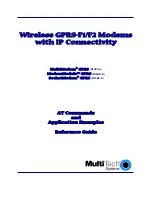
Chapter 2 – Dialing Services
Multi-Tech Systems, Inc. AT Commands for Wireless Modems with IP Connectivity (S000333D)
9
#DIALN2 Set Secondary Dial-Up Number
Definition:
This parameter is the secondary dial-up phone number that will connect with the local ISP. Length
depends on country.
Values:
Decimal phone numbers.
No default.
Syntax:
Set Value: AT#DIALN2=<value>
Get Value: AT#DIALN2? or AT#VPHY, AT#VALL
#DIALSELECT Set Internet Connection Number
Definition:
The value of this command determines the number called to establish an Internet connection. It
configures the TCP/IP stack software to use the primary dial-up number or the secondary dial-up
number.
Values:
1
Use primary dial-up number.
Default 1.
2
Use secondary dial-up number
Syntax:
Set Value: AT#DIALSELECT=<value>
Get Value: AT#DIALSELECT? or AT#VPHY, AT#VALL
#ISPPW Set ISP Password
Definition:
This parameter sets the password for the ISP account. When communication is initiated and once the
physical (modem) connection has been established with the ISP, the TCP/IP stack software must
provide the ISP with the password associated with the account to be used.
Values:
Alpha-numeric ASCII text string up to 64 characters.
No default.
Syntax:
Set Value: AT#ISPPW=<value>
Get Value: AT#ISPPW? or AT#VPPP, AT#VALL
#ISPUN Set ISP User Name
Definition:
This parameter sets the user name of the ISP account. When communication is initiated and the
physical (modem) connection has been established with the ISP, the TCP/IP stack software must
provide the ISP with the user name associated with the account to be used.
Values:
Alpha-numeric ASCII text string up to 64 characters.
No default.
Syntax:
Set Value: AT#ISPUN=<value>
Get Value: AT#ISPUN? or AT#VPPP, AT#VALL
#PPPMODE Set TCP/IP Behavior
Definition:
The TCP/IP stack can manage the access layer in different ways. This parameter selects the way the
TCP/IP stack must run once the physical is layer successfully established.
Values:
Integer between 0 and 4 inclusive.
1
Standard PPP.
The TCP/IP stack behaves as a PPP client for outgoing calls and as a PPP server
for incoming calls.
Default 1.
2
Reverse PPP.
The TCP/IP stack behaves as a PPP server for outgoing calls and as a PPP client
for incoming calls.
3
PPP client only.
The TCP/IP stack always behaves as a PPP client for both outgoing and
incoming calls.
4
PPP server only.
The TCP/IP stack always behaves as a PPP server for both outgoing and
incoming calls.
9
Specific.
This case is reserved for specific behavior.
Syntax:
Set Value: AT#PPPMODE=<value>
Get Value: AT#PPPMODE? or AT#VPPP, AT#VALL










































